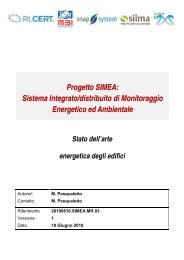Stato dell'arte energetica degli edifici - Automatica - Università degli ...
Stato dell'arte energetica degli edifici - Automatica - Università degli ...
Stato dell'arte energetica degli edifici - Automatica - Università degli ...
Create successful ePaper yourself
Turn your PDF publications into a flip-book with our unique Google optimized e-Paper software.
SIMEA <strong>Stato</strong> dell’arte <strong>energetica</strong> <strong>degli</strong> <strong>edifici</strong><br />
1.2.18. EBS<br />
37<br />
Doc.No 20100610.SIMEA.MR.03<br />
Versione 1<br />
Streamlines utility billing and cost allocation<br />
processes, while greatly improving the reliability and<br />
accuracy of information. EBS (eDNA Billing System) was<br />
designed to meet the complex utility accounting and<br />
reporting needs of a large organization with 100s or 1,000s of buildings and accounts often spread across<br />
multiple campus locations. EBS uses a highly flexible cost allocation structure ensuring direct access to<br />
meter, account, building, and defined group cost and consumption information.<br />
EBS can be integrated with existing business systems and automated meter reading/data collection<br />
devices, or the system can be operated as a stand-alone solution. All utilities can be accounted for, including<br />
electricity, water, metered gas, bulk gas, chilled water, fuel oil and steam. EBS also interfaces to eDNA,<br />
InStep is real-time data historian. With eDNA, EBS becomes the Energy Efficiency Management (EEM)<br />
system. eDNA collects all meter information and other pertinent energy management data through the<br />
building control systems.<br />
1.2.18.1. Validation/Testing<br />
InStep Software has a rigorous Quality Assurance program. InStep is software products are used<br />
throughout the world, including in many Nuclear power facilities where quality assurance paramount.<br />
1.2.18.2. Expertise Required<br />
Full EBS training provided with every EBS product sold. Additional training is available. Knowledge<br />
of the utility billing business process is helpful but not required.<br />
1.2.18.3. Users<br />
Thousands of users in hundreds of plants throughout the world use the eDNA data historian. Users of<br />
EBS include the University of Michigan and North Carolina State University.<br />
1.2.18.4. Audience<br />
Organizations with many buildings or campuses such as corporations, governments, and universities.<br />
1.2.18.5. Input<br />
EBS is configured with many standard engineered unit conversion factors, users may want to add<br />
specific factors conversion factors are easily added to EBS through the user friendly interface to EBS.<br />
1.2.18.6. Output<br />
Information is presented in the preformatted output includes demand schedules, purchased utility cost<br />
and consumption by meter/building and department/fund, generated utility cost and consumption by<br />
meter/building and department/fund. EBS includes rate schedule analysis, text files for general ledger<br />
uploads, vouchers for invoice batching, and an optional interface to accounts payable. EBS also includes a<br />
query tool that allows information to be queried through the reporting engine. EBS utilizes a reporting tool<br />
and also provides a monthly data warehouse file for uploading into an organizations common repository.<br />
Reports can be printed or saved as word processing, spreadsheet, database, PDF, or RTF. EBS Web provides<br />
web-based access to EBS reports, trend tools and meter level information.
















